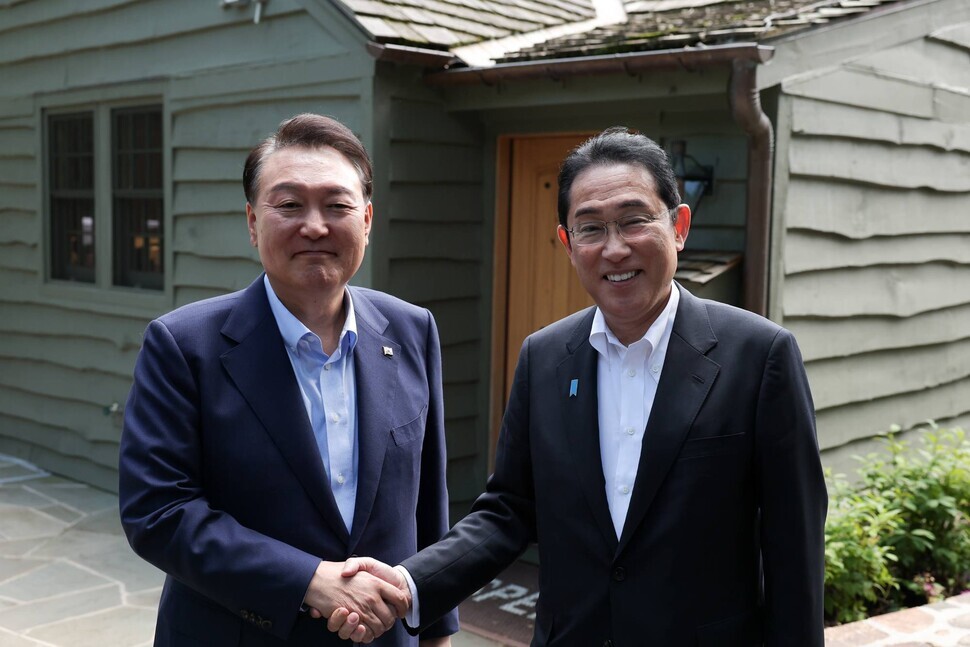hankyoreh
Links to other country sites 다른 나라 사이트 링크
D-1 to Fukushima nuclear wastewater release: Seoul says “no issues” with Tokyo’s plan

The Japanese government officially announced that the discharge of water contaminated with radionuclides from the Fukushima Daiichi nuclear power plant would begin Thursday.
The Japanese Cabinet resolved in a meeting on Tuesday to begin dumping contaminated water into the ocean as early as Thursday.
Japanese Prime Minister Fumio Kishida said he expects the contaminated water discharge will begin on Thursday “as long as there is no interference from the meteorological and maritime conditions.”
“The government will take responsibility until we have finished disposing of the treated water” — that is, the contaminated water — “which will take decades,” the Japanese leader said.
“Accurate understanding [of our plan] is definitely spreading in the international community,” Kishida said, while mentioning the report released by the International Atomic Energy Agency (IAEA) on Sept. 4 that described the Japanese government’s plan to discharge the contaminated water as satisfying international standards.
Groundwater continues to flow into the Fukushima nuclear plant, where hydrogen explosions went off following an earthquake and tsunami in March 2011, producing around 1.34 million metric tons of contaminated water to date.
The Japanese government has stored the contaminated water in 1,073 tanks on the site of the plant. But in April 2021, it decided to start dumping the water into the ocean for various reasons, including a lack of space needed to decommission the plant.
There are alternatives to dumping the contaminated water into the ocean — it could have been vaporized and released into the atmosphere or solidified and buried underground, for example. But the Japanese government has stuck with the ocean discharge plan, despite the resulting harm to neighboring countries and its own fishermen, because an ocean discharge has precedent and will be easier to monitor.
Japan has touted the upbeat assessment in the IAEA’s final report while attempting to allay the concerns of neighboring countries including South Korea, China and island nations in the Pacific Ocean.
On Tuesday, the IAEA reiterated in a statement that Japan’s plans for the discharge “are consistent with relevant international safety standards” and noted that IAEA staff will “monitor and assess these activities on site to ensure that they continue to be consistent with the safety standards, including on the day of the start of the discharge and after.”
The Japanese government never managed to overcome opposition from its domestic fishing industry, which will be directly impacted by the discharge of contaminated water, and Tetsu Nozaki, head of the Fukushima Prefectural Fisheries Federation, promised to “oppose [the discharge] until the very last drop.” But that wasn’t enough to sway policymakers in Tokyo.
Kishida, the prime minister, made a point of visibly continuing his persuasion campaign until the last minute in a meeting with Masanobu Sakamoto, chairperson of Japan’s National Federation of Fisheries Cooperatives, on Monday, the day before the final decision.
The Korean government has essentially decided to sanction Tokyo’s decision, remarking in a statement that “we have concluded there are no scientific or technical issues with the discharge plans.”
Park Gu-yeon, the first deputy director of Korea’s Office for Government Policy Coordination, did stipulate that Korea would “regard the slightest deviation from Japan’s planned discharge as a threat to the safety and health of the Korean public and ask Japan to immediately halt the discharge.”
By Kim So-youn, Tokyo correspondent; Cho Ki-weon, staff reporter; Shin Min-jung, staff reporter
Please direct questions or comments to [english@hani.co.kr]

Editorial・opinion
![[Editorial] Silence won’t save Yoon [Editorial] Silence won’t save Yoon](https://flexible.img.hani.co.kr/flexible/normal/500/300/imgdb/original/2024/0701/681719819632087.jpg) [Editorial] Silence won’t save Yoon
[Editorial] Silence won’t save Yoon![[Column] The miscalculations that started the Korean War mustn’t be repeated [Column] The miscalculations that started the Korean War mustn’t be repeated](https://flexible.img.hani.co.kr/flexible/normal/500/300/imgdb/original/2024/0630/9717197068967684.jpg) [Column] The miscalculations that started the Korean War mustn’t be repeated
[Column] The miscalculations that started the Korean War mustn’t be repeated- [Correspondent’s column] China-Europe relations tested once more by EV war
- [Correspondent’s column] Who really created the new ‘axis of evil’?
- [Editorial] Exploiting foreign domestic workers won’t solve Korea’s birth rate problem
- [Column] Kim and Putin’s new world order
- [Editorial] Workplace hazards can be prevented — why weren’t they this time?
- [Editorial] Seoul failed to use diplomacy with Moscow — now it’s resorting to threats
- [Column] Balloons, drones, wiretapping… Yongsan’s got it all!
- [Editorial] It’s time for us all to rethink our approach to North Korea
Most viewed articles
- 1Japan is building a military meant for more than self-defense — and has the US to thank for it
- 2[Editorial] Silence won’t save Yoon
- 3Yoon’s prosecutors are throwing everything at the president’s opponents to see what’ll stick
- 4NewJeans rocks Tokyo Dome as new, younger generation of K-pop fans emerges in Japan
- 5[Column] The miscalculations that started the Korean War mustn’t be repeated
- 6What made Korea’s lithium battery plant fire so deadly
- 7Dreams of a better life brought them to Korea — then a tragic fire tore them apart
- 8Moscow tells Seoul to rethink ‘confrontational course’
- 9Yoon echoed conspiracy theories about Itaewon disaster, former National Assembly speaker says
- 10Half of South Korea’s conglomerate heirs marry within chaebol community